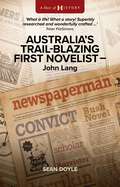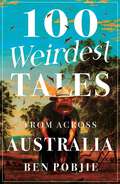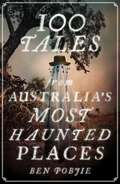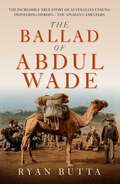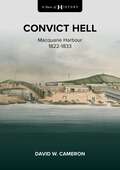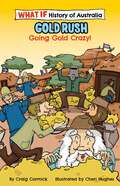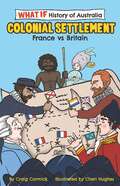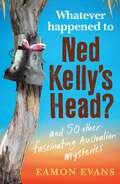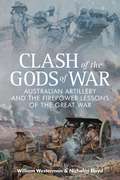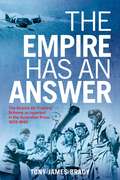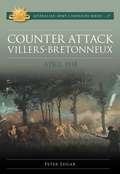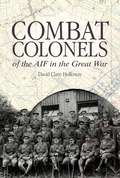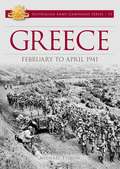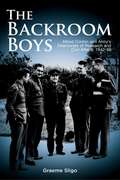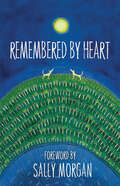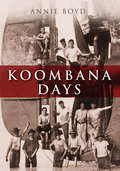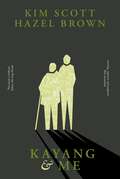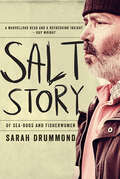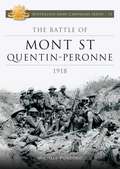- Table View
- List View
Australia's Trail-Blazing First Novelist: John Lang
by Sean Doyle'Writer, journalist, barrister, larrikin' Who was the first Australian novelist? John Lang, born in a Parramatta pub in 1816 with the convict &‘stain&’ upon him, was a singular character. The first native-born person to have a novel published, he was also a newspaperman, a classical scholar and translator, barrister, celebrity, jailbird … enigma. He was hugely energetic, capable and original, but he also had his demons. A larrikin polymath who refused to be bound by convention, Lang didn&’t just want his allotted portion – he wanted all of it. He got a lot of it, too, but not the chalice of immortality. Lang was a serial pioneer. In literature, he also wrote the first &‘detective novel&’ in English, the first convict-system satire, the first Indian travelogue by an Australian, and he created the template for the bush novel. In journalism, he was the first Australian to launch and run a newspaper overseas. And in law, he was the only barrister to ever defeat the mighty East India Company in an Indian courtroom. So why have we never heard of him? This long-overdue biography explores answers to this revealing question as it tracks Lang&’s rise from those humble beginnings to fortune and fleeting fame. Author Sean Doyle tells the riveting story of Lang&’s remarkable life and times across three continents in the age of Empire, when the modern world was young …
100 Weirdest Tales from Across Australia
by Ben PobjieTales of the strange, unnerving and downright bizarre from one of the weirdest places on EarthFish falling out of the sky, joggers relieving themselves on your doorstep, mysterious monsters constantly springing from the shadows, spooky lights and ill-conceived toast spreads: these are just some of the things you can expect on any given day in our surreal southern land.In 100 Weirdest Tales from Across Australia, comedy writer and accredited weirdness expert Ben Pobjie delves deep into Australia's past and present to serve up the weirdest stories of all, which will leave you smacking your gob with one hand while scratching your head with the other.
100 Weirdest Tales from Across Australia
by Ben PobjieTales of the strange, unnerving and downright bizarre from one of the weirdest places on EarthFish falling out of the sky, joggers relieving themselves on your doorstep, mysterious monsters constantly springing from the shadows, spooky lights and ill-conceived toast spreads: these are just some of the things you can expect on any given day in our surreal southern land.In 100 Weirdest Tales from Across Australia, comedy writer and accredited weirdness expert Ben Pobjie delves deep into Australia's past and present to serve up the weirdest stories of all, which will leave you smacking your gob with one hand while scratching your head with the other.
100 Tales from Australia's Most Haunted Places
by Ben PobjieFrom the ghostly black horse of Sutton Forest to the butcher of Adelaide Street, a haunted Brisbane lift to the chilling experiments carried out by Doctor Blood of the North Kapunda Hotel, Australia abounds in spooky stories that are all unnervingly based in fact and tied to real places you can visit or avoid. In 100 Tales from Australia's Most Haunted Places, comedy writer and general scaredy-cat Ben Pobjie communes with the spirit world to send a shiver down your spine. A book best read with the light left on.
100 Tales from Australia's Most Haunted Places
by Ben PobjieFrom the ghostly black horse of Sutton Forest to the butcher of Adelaide Street, a haunted Brisbane lift to the chilling experiments carried out by Doctor Blood of the North Kapunda Hotel, Australia abounds in spooky stories that are all unnervingly based in fact and tied to real places you can visit or avoid. In 100 Tales from Australia's Most Haunted Places, comedy writer and general scaredy-cat Ben Pobjie communes with the spirit world to send a shiver down your spine. A book best read with the light left on.
The Ballad of Abdul Wade: The Incredible True Story of Australia's unsung Pioneering Heroes - The Afghan Camelleers
by Ryan ButtaWhen Afghan entrepreneur Abdul Wade first brought his camel trains to the outback, he was hailed as a hero. Horses couldn't access many remote settlements, especially those stricken by flood or drought, and camel trains rode to the rescue time and time again.But with success came fierce opposition fuelled by prejudice. The camel was not even classed as an animal under Australian law, and, in a climate of colonial misinformation, hyperbole and fear, camel drivers like Wade were shown almost as little respect. Yet all the while, for those in need, the ships of the desert continued to appear on the outback horizon.After his interest was piqued by a nineteenth-century photo of a camel train in a country town, Ryan Butta found himself on the trail of Australia's earliest Afghan camel drivers. Separating the bulldust from the bush poetry, he reveals the breadth and depth of white Australian protectionism and prejudice. Told with flair and authority, this gritty alternative history defies the standard horse-powered folklore to reveal the untold debt this country owes to the humble dromedary, its drivers and those who brought them here.
The Ballad of Abdul Wade: The Incredible True Story of Australia's unsung Pioneering Heroes - The Afghan Cameleers
by Ryan ButtaWhen Afghan entrepreneur Abdul Wade first brought his camel trains to the outback, he was hailed as a hero. Horses couldn't access many remote settlements, especially those stricken by flood or drought, and camel trains rode to the rescue time and time again.But with success came fierce opposition fuelled by prejudice. The camel was not even classed as an animal under Australian law, and, in a climate of colonial misinformation, hyperbole and fear, camel drivers like Wade were shown almost as little respect. Yet all the while, for those in need, the ships of the desert continued to appear on the outback horizon.After his interest was piqued by a nineteenth-century photo of a camel train in a country town, Ryan Butta found himself on the trail of Australia's earliest Afghan camel drivers. Separating the bulldust from the bush poetry, he reveals the breadth and depth of white Australian protectionism and prejudice. Told with flair and authority, this gritty alternative history defies the standard horse-powered folklore to reveal the untold debt this country owes to the humble dromedary, its drivers and those who brought them here.
A Shot of History: Macquarie Harbour 1822-1833 (A Shot of History #1)
by David W. CameronThe year 2022 marks the 200th anniversary of the establishment of the penal settlement at Macquarie Harbour. This convict penal settlement located on the isolated primeval rugged west coast of Van Diemen&’s Land (Tasmania) quickly gained a reputation as an &‘Earthy Hell&’. Colonial historian John West succinctly recorded in 1852: &‘The name Macquarie Harbour is associated exclusively with remembrance of inexpressible depravity, degradation, and woe. Sacred to the genius of torture, Nature concurred with the objects of its separation from the rest of the world, to exhibit some notion of a perfect misery. There, man lost the aspect and the heart of man …. This region is lashed with tempests: the sky is cloudy, and the rain falls more frequently than elsewhere. In its chill and humid climate, animal life is preserved with difficulty; half the goats died in one season, and sheep perished; vegetation, except in its coarsest and most massive forms is situated and precarious …. The passage to this dreary dwelling place was tedious and often dangerous. The prisoners, confined in a narrow space, were tossed for weeks on an agitated sea. As they approached, they beheld a narrow opening chocked with a bar of sand and crossed with peril. This they called Hell&’s Gate – not less appropriate to the place than to the character and torment of the inhabitants: beyond they saw impenetrable forests, skirted with an impervious thicket; and beyond still enormous mountains covered with snow, which rose to the clouds like walls of adamant: every object wore the air of rigour, ferocity, and sadness&’. This was just the beginning for those sentenced to Macquarie Harbour the barbaric treatment from officials and fellow convicts alike, resulted in Macquarie Harbour representing a true convict hell hole, not only resulting in murder, but in cannibalism by several men in their attempts to escape.
The What If Histories of Australia: Gold Rush: Going Gold Crazy
by Craig CormickGold Fever is what makes ordinary people act like completely crazy people . We all know that gold makes people act a bit crazy – but imagine just how peculiar things would be if the 19th Century Australian colonies were all run by different countries. The French and British find devious ways to steal each other&’s gold. First Nations people, diggers and bushrangers have their own crafty plans. And a peculiar bushranger in armour tries to start a new Irish republic ... what happens next could be anyone's guess!The What If histories of Australia imagine a very different history of Australia, where the unexpected happens in unexpected ways. Starting by defining the real histories, the book then looks at possible, amusing paths that history could have taken.
The What If Histories of Australia: Colonial Settlement: France vs Britain
by Craig CormickAn amusing look at the alternative paths that Australian history might have taken.The What If histories of Australia imagines a very different history of Australia, where the unexpected happens in unexpected ways. Starting by defining the real histories, the book then looks at possible paths of different settlements that history could have taken. What if Captain Cook&’s ship sank when it hit the Great Barrier Reef in 1770? And what if the French settled Australia first? And what if King Louis 16th and Napoleon both ended up here, fighting over who was the rightful ruler in exile? And then the British arrived… A very different and amusing history of Australia, where the unexpected happens in unexpected ways.
What Ever Happened to Ned Kelly's Head?
by Eamon EvansWho stole the priceless Picasso from the NGV? Was Errol Flynn a Nazi spy? Did an Australian kill the infamous Red Baron?If you think Australia’s history is straightforward, you’re dead wrong. This is a land of the strange, the spooky and the unexplained. From the eerie ball of light that stalked a terrified family across the Nullabor, to the whereabouts of Victoria’s parliamentary mace, to the unidentified body found propped up on an Adelaide beach, and, yes, to the whereabouts of Ned Kelly’s skull, you’ll find our history has plenty of mysterious twists and unanswered questions.With his signature wit, Eamon Evans’ investigates Australia’s most curious mysteries, digs up the evidence and lays it out for the court of public opinion to decide. Whatever Happened to Ned Kelly’s Head will have you scratching your head and wondering long after the last page.
What Ever Happened to Ned Kelly's Head?
by Eamon EvansWho stole the priceless Picasso from the NGV? Was Errol Flynn a Nazi spy? Did an Australian kill the infamous Red Baron? If you think Australia's history is straightforward, you're dead wrong. This is a land of the strange, the spooky and the unexplained. From the eerie ball of light that stalked a terrified family across the Nullabor, to the whereabouts of Victoria's parliamentary mace, to the unidentified body found propped up on an Adelaide beach, and, yes, to the whereabouts of Ned Kelly's skull, you'll find our history has plenty of mysterious twists and unanswered questions. With his signature wit, Eamon Evans' investigates Australia's most curious mysteries, digs up the evidence and lays it out for the court of public opinion to decide. Whatever Happened to Ned Kelly's Head will have you scratching your head and wondering long after the last page.
Clash of the Gods of War: Australian Artillery and the Firepower Lessons of the Great War
by William Westerman Nicholas FloydThe Great War confronted Australia’s fledgling field and garrison artillery forces with a seemingly insurmountable challenge: to rapidly raise, prepare, deploy and engage in history’s most lethal war to date. By 1915, the Australian artillery entered into a bloody contest of learning and adaptation against resourceful and resolute opponents, where the stakes would be measured in thousands of soldiers’ lives. Far from popularly-held views of the Great War as one of stalemate and stagnation, Clash of the Gods of War: Australian Artillery and the Firepower Lessons of the Great War reveals a dynamic and rapidly evolving battle-scape, as artillery planners on each side sought to combine innovative concepts, technology and tactics into victory. The book draws on an unparalleled array of perspectives on artillery and firepower, presented by Australian and international experts and practitioners over four years during the Firepower: Lessons from the Great War seminar series, commemorating the Centenary of Anzac. From Anzac Cove to the Hindenburg Line, Clash of the Gods of War tells a gripping Australian story of the Great War through the lens of artillery – the most lethal and influential arm of the war – and considers the legacy that its evolutionary journey holds for warfare today.
The Empire Has An Answer: The Empire Air Training Scheme as Reported in the Australian Press 1939-1945
by Tony James Brady&If we do not win the battle of training, we shall win no other battle in the air.’ In 1943 the Royal Air Force recognised that training a vast amount of aircrew for a high attrition war was essential to an Allied victory, and that the key to winning the ‘battle of training’ was the Empire Air Training Scheme (EATS). 37,576 Australian aircrew graduated from the EATS. Over 300 were killed whilst training for war and 9874 aircrew were killed or listed as missing while on active duty. Those who fought under this scheme during World War II amounted to just 6.7 per cent of Australian service personnel serving overseas yet the aircrew losses amounted to almost 25 per cent of all the Australian fatalities during the war. This made serving in EATS among the most hazardous duties of the war. The Empire has an Answer was researched using more than 35 000 articles, from 150 metropolitan, regional, and district newspapers, and what materialised was a story of one of, if not, the greatest training programs the world has seen. Follow the journey from the conception and implementation of the scheme, through recruitment and basic training, flight training, and then into combat. The individual accounts woven into the narrative provide a first-hand experience of the triumphs and trials of typical airmen and airwomen who performed extraordinary feats in a time of great need. The significant achievements and success of the Empire Air Training Scheme has for the most part been overlooked in our history, until now.
First and Foremost: A Concise Illustrated History of 1st Battalion, the Royal Australian Regiment, 1945 - 2018
by Bob BreenThis history has been published to mark 70 years of service as well as the 50th Anniversary of the battle of Coral/Balmoral in Vietnam in 1968, the 25th Anniversary of service in Somalia in 1993 and the 10th anniversary of service in Afghanistan in 2008/09. It covers only the ‘wave tops’ of 70 years of history and mentions only a few individuals, mostly commanding officers or contingent commanders who had ultimate responsibility for operational success or failure; thus, deserving their prominence. Photographs and tables do their best to enhance the narrative in the expectation of, ‘A picture is worth a 1000 words’. By measures of its operational record, The 1st Battalion, The Royal Australian Regiment is one of the first and foremost battalions of the Royal Australian Regiment.
Counter Attack Villers-Bretonneux: April 1918 (Australian Army Campaigns #27)
by Peter EdgarThe brutal 1914 German invasion of Belgium and France had gained a large portion of both countries. Over three-and-a-half punishing years the Allies were slowly pushing the Germans back but in March 1918, Germany launched a massive spring offensive. Resting in the Ypres sector after the horrors of the Passchendaele campaign, the Australians were among the first sent south to try to block the enemy. Now, after an unprecedented fortnight of advance, Germany’s goal was to capture the town of Villers-Bretonneux, key to the major rail junction of Amiens. The first attempt on 4 April found the 9th Australian Infantry Brigade in the centre of the line. They stopped the enemy at the gates. Then on 24 April the Germans launched a new attack, led by tanks, and took the town. Standing by to counter-attack were the 15th and 13th brigades of the Australian Corps. Not everything went to plan and casualties were high, but the counter-attack was brilliantly executed in spite of the odds. It became ‘a soldier’s fight’ in which the Australian troops’ morale and eagerness to get to grips with the enemy, together with their aggressive, well-practised moves under fire triumphed. Counter Attack: Villers-Bretonneux – April 1918 details the pivotal role the Australians played in denying German victory. Villers-Bretonneux was never again threatened by the enemy.
Combat Colonels: of the AIF in the Great War
by David Clare HollowayCombat Colonels seeks to address the regrettable gap in Australia's documented history of its combat colonels. Its purpose is to name all the Commanding Officers who led units into actions in the Great War and to describe their lives before and, for those who survived, after the war. From these pages emerge the men who shaped Australia's battlefield history - both the professional soldiers and the former teachers, accountants, salesmen, clerks, farmers and others from a broad range of occupations whose leadership on and off the battlefield proved so crucial. These are men Australia cannot afford to forget.
Greece: February To April 1941 (Australian Army Campaigns #13)
by Michael TyquinAs with the failed attempt to seize the Gallipoli peninsula in 1915, the allied campaign to assist Greece against a seemingly invincible German juggernaut was poorly conceived and probably doomed even as plans were made to assist that country. Like any campaign, however, it holds lessons for the contemporary student of strategy, tactics and history. Greece presented singular geographic difficulties for the defending forces, its mountainous defiles dictating the distribution of ports, road and rail routes. The primitive state of the national infrastructure did little to help a long-term defensive posture. Operations in Greece proved to be a nightmare, particularly for logistics units, which struggled with primitive communication systems in rugged terrain over which the enemy enjoyed total air superiority. Poor liaison between the Greek and Commonwealth forces did not help matters, nor was the force deployed adequate for its task. The allies never enjoyed air superiority, nor could they consolidate any in-depth defence in time to be effective. The official British history of the campaign stated that the ‘British campaign on the mainland of Greece was from start to finish a withdrawal'. Greece: February to April 1941 explores these complexities, and mistakes through the eyes of the Australian Army Medical Corps.
The Backroom Boys: Alfred Conlon and Army's Directorate of Research and Civil Affairs,1942-46
by Graeme SligoThe Backroom Boys is the remarkable, but little known, story of how a varied group of talented intellectuals, drafted into the Australian Army in the dark days of 1942, provided high-level policy advice to Australia’s most senior soldier, General Blamey, and through him to the Government for the remainder of the war and beyond. This band of academics, lawyers and New Guinea patrol officers formed a unique military unit, the Directorate of Research and Civil Affairs, under the command of an eccentric and masterful string-puller, Alf Conlon. The Directorate has been depicted as a haven for underemployed poets or meddlesome soldier-politicians. Based on wide-ranging research, this book reveals a fuller and more fascinating picture. The fierce conflicts in the wartime bureaucracy between public servants and soldiers, in which the Directorate provided critical support to Blamey, went to the heart of military command, accountability and the profession of arms. The Directorate was a pioneer in developing approaches to military government in areas liberated by the combat troops, as demonstrated by the Australian Army in New Guinea, and Borneo in 1945-46. It is an issue of enduring importance. The Directorate established the Australian School of Pacific Administration, and had an important role in founding the Australian National University. Its influence extended into post war Australia. The Backroom Boys emphasises the personality of Colonel Alf Conlon, as well as the talented men and women he recruited. Above all, this book shows how, unexpectedly, the Australian Army fostered a group of men and women who made a lasting contribution to the development of Australia in the decades after the war.
Remembered by Heart
by Sally MorganA collection of powerful, true stories of Aboriginal life This anthology brings together 15 memoirs of growing up Aboriginal in Australia and includes works from Kim Scott, Australia's first indigenous Miles Franklin winner; bestselling author Sally Morgan; and the critically acclaimed artist, author, and activist Bronwyn Bancroft. These true stories of adolescence are as diverse as they are moving, and offer readers insight into the pain, humor, grief, hope, and pride that makes up Indigenous experiences.
Koombana Days
by Annie BoydThe elegant, ultra-modern SS Koombana arrived in Western Australia in March 1909; after only three years of service in the North West of Australia, the ship and her entire complement disappeared in a late-summer cyclone off the Pilbara coast in 1912. All 156 lives were lost but the wreck was never found. This thoroughly researched and compelling book comes closer than ever before to solving the mystery of Australia’s most significant maritime disaster. Author Annie Boyd spent months camping along the coast, diving and investigating wrecks, researching the Koombana, and meeting with descendants of those lost in the tragedy. This insightful account is the culmination of her work, which includes a 20,000 page online resource with background material and primary sources.
Kayang & Me
by Kim Scott Hazel BrownA monumental family history of Australia's Wilomin Noongar people, this is a powerful story of community and belonging. Revealing the deep and enduring connections between family, country, culture, and history that lie at the heart of indigenous identity, this book—a mix of storytelling and biography—offers insight into a fascinating community.
Salt Story: Of Sea-Dogs and Fisherwomen
by Sarah DrummondIn this warm, lively account of living on and by the sea, Sarah Drummond writes of life as an apprentice fisherwoman. Through her firsthand experience with small-scale commercial fishing in the Great Southern, Drummond documents a way of life—fishing—that is slowly dying as waters become politicized and fished out. She writes of fishing, of feuds, and of all the fish that got away. Salt Story is a tribute to sea-dogs, fisherwomen, oystermen, and storytellers everywhere.
Amazing People of Australia - A Short eBook
by Charles MargerisonAustralia has developed to become a model multi-ethnic society. In this collection of life stories from The Amazing People Club, you can gain an insight into how some amazing Australians set the scene and contributed to the country we fondly refer to as Downunder. Embark on a thrilling flight of discovery with Charles Kingsford Smith. His courage, competitive spirit and daring sense of adventure led to him being regarded as one of the highest achievers in the history of aviation. Be inspired by the entrepreneurial talent of James Harrison who invented the refrigerator which has become a necessity in our homes of today. Be captivated by the tumultuous events in the life of Nellie Melba, a self-driven diva who achieved great success and became one of Australia's most celebrated sopranos of all time. Meet these and several other amazing Australians who in their own unique ways, seized opportunities that led to great successes. Each story comes to life through BioViews®. These are short biographical narratives, similar to interviews. They provide an easy way of learning about amazing people who made major contributions and changed our world.
The Battle of Mont St Quentin Peronne 1918: The Battle of Mont St Quentin-Peronne 1918 (Australian Army Campaigns #11)
by Michele BomfordThe Battle of Mont St Quentin-Peronne 1918 explores the relationship between myth and history and the significance of the Anzac legend. It analyses the forces that drove the diggers forward even when they had reached the limits of their endurance. The Battle of Mont St Quentin-Peronne represents the Australian Corps at its very best, its diggers fighting for peace and satisfied that, `whatever might lie ahead, at least everything was right behind them'.
